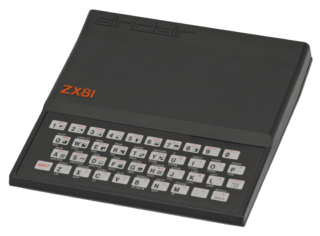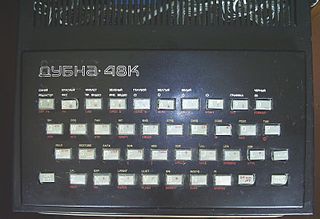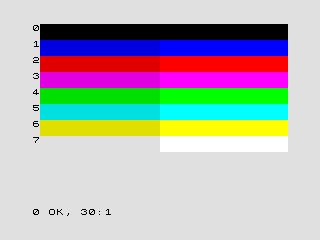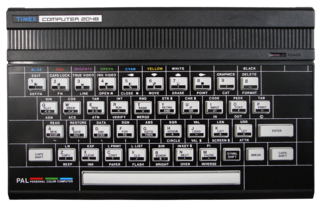Related Research Articles

The ZX Spectrum is an 8-bit home computer that was developed by Sinclair Research. It was released in the United Kingdom on 23 April 1982, and became Britain's best-selling microcomputer.

The ZX81 is a home computer that was produced by Sinclair Research and manufactured in Dundee, Scotland, by Timex Corporation. It was launched in the United Kingdom in March 1981 as the successor to Sinclair's ZX80 and designed to be a low-cost introduction to home computing for the general public. It was hugely successful; more than 1.5 million units were sold. In the United States it was initially sold as the ZX-81 under licence by Timex. Timex later produced its own versions of the ZX81: the Timex Sinclair 1000 and Timex Sinclair 1500. Unauthorized ZX81 clones were produced in several countries.
Sinclair BASIC is a dialect of the programming language BASIC used in the 8-bit home computers from Sinclair Research and Timex Sinclair. The Sinclair BASIC interpreter was made by Nine Tiles Networks Ltd.

The Timex Sinclair 1000 was the first computer produced by Timex Sinclair, a joint venture between Timex Corporation and Sinclair Research. It was launched in July 1982, with a US sales price of US$99.95, making it the cheapest home computer at the time; it was advertised as "the first computer under $100". The computer was aimed at regular home users. As purchased, the T/S 1000 was fully assembled and ready to be plugged into home televisions, which served as a video monitor. The T/S 1000 was a slightly modified version of the Sinclair ZX81 with an NTSC RF modulator, for use with North American TVs, instead of PAL for European TVs. The T/S 1000 doubled the onboard RAM from 1 KB to 2 KB; further expandable by 16 KB through the cartridge port. The T/S 1000's casing had slightly more internal shielding but remained the same as Sinclair's, including the membrane keyboard. Just like the ZX81, the T/S 1000 had black-and-white graphics and no sound.

The Timex Sinclair 2068, released in November 1983, was Timex Sinclair's third and last home computer for the United States market. It was also marketed in Canada, Argentina, Portugal and Poland, as Timex Computer 2068.
The Didaktik was a series of 8-bit home computers based on the clones of Intel 8080 and Zilog Z80 processors produced by Didaktik in Skalica, in the former Czechoslovakia.
Sinclair Research Ltd is a former British consumer electronics company founded by Clive Sinclair in Cambridge. It was originally incorporated in 1973 as Westminster Mail Order Ltd, renamed Sinclair Instrument Ltd, then Science of Cambridge Ltd, then Sinclair Computers Ltd, and finally Sinclair Research Ltd. It remained dormant until 1976, when it was activated with the intention of continuing Sinclair's commercial work from his earlier company Sinclair Radionics, and adopted the name Sinclair Research in 1981.

The TK90X was a Brazilian ZX Spectrum clone made in 1985 by Microdigital Electrônica, a company from São Paulo, that had previously manufactured ZX80 and ZX81 clones.
Timex Sinclair was a joint venture established in December 1982 between the British company Sinclair Research and Timex Corporation in an effort to gain an entry into the rapidly growing early-1980s home computer market in North America.

The Dubna 48K is a Soviet clone of the ZX Spectrum home computer launched in 1991. It was based on an analogue of the Zilog Z80 microprocessor. Its name comes from Dubna, a town near Moscow, where it was produced on the "TENSOR" instrument factory, and "48K" stands for 48 KBs of RAM.

The TK 95 microcomputer was a 1986 ZX Spectrum clone by Microdigital Eletrônica, a company located at São Paulo, Brazil. It was an evolution of the TK90X introduced the previous year.

The original ZX Spectrum computer outputs video through an RF modulator and was designed for use with contemporary 1980s television sets, for a simple colour graphic display.

The Timex Computer 2048 or TC 2048 is a 1984 computer developed by Timex Portugal, at the time part of Timex Sinclair. It was based on the Timex Sinclair 2048 prototype, with a similar redesign case, composite video output, Kempston joystick interface, and additional video modes, while being highly compatible with the Sinclair ZX Spectrum computer.

The Timex FDD 3000 in 1982 was a nearly complete computer by Timex of Portugal. It began its development at Timex Computer Corporation in the U.S., but it was at Timex of Portugal that the work was finished.
Ringo R-470 was a Brazilian clone of the Sinclair ZX81 by Ritas do Brasil Ltda. introduced in 1983. It featured a Z80A processor at 3.25 MHz, 8K ROM and 16 KB RAM. It wasn't 100% compatible with the ZX81, and some BASIC tokens have alternate codings.

The Lambda 8300 was a Sinclair ZX81 clone from Lambda Electronics Limited of Hong Kong. It had a modified ROM and extra hardware, making it not fully compatible. Total compatibility could be achieved by installing a ZX81 ROM.

The Unipolbrit Komputer 2086 was a Polish version of the home computer Timex Sinclair 2068, produced by a joint venture of the Polish state-owned Unimor and foreign company Polbrit International. Introduced in 1986, the computer had a cost of roughly 190000 zł.
The TC 3256 or Timex Computer 3256 was a 1987 computer created by Timex of Portugal, a branch of Timex Corporation.
References
- ↑ "Tadeo Czerweny History". Tadeo Czerweny. Retrieved 2023-01-16.
- 1 2 "Czerweny Electronica, Argentina". Kio's Sinclair ZX Computers Archive. Retrieved 2023-01-16.
- 1 2 3 "CZ – 1000 Plus". Museo de Informática de la República Argentina (in Spanish). Retrieved 2023-01-16.
- ↑ Owen, Chris (2003). "South American clones". Planet Sinclair. Retrieved 2023-01-16.
- 1 2 3 4 5 Tomoyose, Guillermo (2016-04-05). "La historia de Czerweny CZ Spectrum, la computadora Sinclair con sello argentino". LA NACION (in Spanish). Retrieved 2023-01-16.
- 1 2 "Czerweny CZ-1000". www.old-computers.com. Retrieved 2023-01-16.
- 1 2 "Czerweny Electronica CZ 1000". Kio's Sinclair ZX Computers Archive. Retrieved 2023-01-16.
- 1 2 3 4 5 6 7 8 9 10 Zangoni, Néstor (2005-01-07). "CZERWENY Series (CZ) Argentina (Z80A)". MicroHobby Web independiente para usuarios de ordenadores Sinclair y compatibles (in Spanish). Retrieved 2023-01-16.
- 1 2 "Czerweny CZ 1500". Center for Computing History. Retrieved 2023-01-16.
- 1 2 "Czerweny Electronica CZ 1500". Kio's Sinclair ZX Computers Archive. Retrieved 2023-01-16.
- 1 2 "Czerweny CZ-2000". www.old-computers.com. Retrieved 2023-01-16.
- 1 2 "Czerweny CZ 2000". Sinclair Collection Site.
- 1 2 "Czerweny CZ-1000 Plus". www.old-computers.com. Retrieved 2023-01-16.
- 1 2 "Czerweny Electronica CZ 1000plus". Kio's Sinclair ZX Computers Archive. Retrieved 2023-01-16.
- 1 2 "Czerweny Electronica CZ 1500plus". Kio's Sinclair ZX Computers Archive. Retrieved 2023-01-16.
- 1 2 "Czerweny Spectrum". www.old-computers.com. Retrieved 2023-01-16.
- 1 2 "Czerweny CZ Spectrum". Sinclair Collection Site.
- 1 2 "Czerweny Spectrum Plus". www.old-computers.com. Retrieved 2023-01-16.
- 1 2 "Czerweny CZ Spectrum Plus". Sinclair Collection Site.
